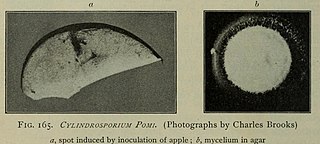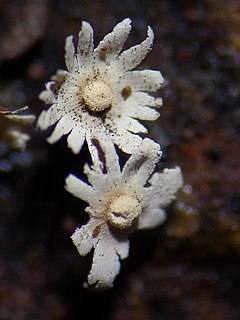
Mycosphaerella pomi is a fungus in the Mycosphaerellaceae family.
Cadophora malorum is a plant pathogen that causes side rot in apple and pear and can also cause disease on asparagus and kiwifruit.
Asteridiella is a genus of fungi in the family Meliolaceae. The genus was first described by Daniel McAlpine in 1897, who differentiated it from various other fungal genera:
"Asterula, Sacc, has continuous hyaline spores (Hyalosporae), Asteronia, Sacc, has continuous brown spores (Phaeosporae). Asterina, Lev., has two-celled hyaline spores (Hyalodidymae). Asterella, Sacc, has two-celled brown spores (Phaeodidymae). Asteridium, Sacc, has multi-septate hyaline spores (Hyalophragmiae). And in the case of the specimen on Solanum viride with multi-septate brown spores, I have ventured to use Asteridiella (Phaeophragmiae)".
Menegazzia stirtonii is a species of foliose lichen found in New Zealand, and Tasmania, Australia.
Lepraria sekikaica is a species of lichen in the family Lecanoraceae. Known from Western Australia where it grows on the ground under sheltered rock ledges, it was described as new to science in 2011.
Coenogonium implexum is a yellow-green byssoid lichen with light orange apothecia found in Australia. It is in the Coenogoniaceae family, and was first described by William Nylander in 1857.
Paradiacheopsis is an genus of slime molds in the family Amaurochaetaceae. It was first described by Ralph Joao George Hertel in 1954, and the type species is Paradiacheopsis curitibana.

Panus purpuratus is a fungus in the family, Panaceae, first described by Greta Stevenson in 1964. The type species was collected from fallen wood in a coastal forest in Waikanae in 1949. The species is endemic to New Zealand.
Acarospora citrina is a lichen in the family, Acarosporaceae, first described as Urceolaria citrina by Thomas Taylor in 1847. It was assigned to the genus, Acarospora, in 1913 by Alexander Zahlbruckner.
Trapelia thieleana is a lichenised fungus in the family, Trapeliaceae. It was first described in 2014 by the mycologists, Gintaras Kantvilas, Steven Leavitt, John Elix and Thorsten Lumbsch.

Trapelia coarctata is a lichenised fungus in the family, Trapeliaceae.

Cladonia coniocraea, commonly known as the common powderhorn or the powderhorn cup lichen, is a species of fruticose, cup lichen in the family Cladoniaceae. It was first described by Heinrich Gustav Flörke in 1821 under the name Cenomyce coniocraea, until Kurt Polycarp Joachim Sprengel reclassified it under the genus Cladonia in 1827.

Blastenia is a genus of fungi belonging to the family Teloschistaceae. The genus was first described in 1852 by Abramo Bartolommeo Massalongo.
Boeremia is a genus of fungi belonging to the family Didymellaceae. It was first described by M.M. Aveskamp, J. de Gruyter, J.H.C. Woudenberg, G.J.M. Verkley and P.W. Crous in 2010, and the type species is Boeremia exigua.
Enteridium is a genus of slime molds belonging to the family Reticulariaceae.
Lachnea is a genus of fungi belonging to the family Pyronemataceae. The genus was first described in 1822 as Peziza ser. Lachnea by Elias Magnus Fries. This was elevated to genus status by Claude Casimir Gillet in 1880.
Diderma stellulum is a species of slime mould in the family Didymiaceae, first described by Marie Leonore Farr in 1988. It is found in Brazil, in tropical semideciduous forest.

Diderma subasteroides is a species of slime mould in the family Didymiaceae, first described by Marie Leonore Farr in 1971. It has been found in Africa, South America and Australia.
Asteridiella selaginellae is a species of fungus in the family Meliolaceae, first described by Marie Leonore Farr in 1968. It has been found in Mexico on the leaves of Selaginella pilifera.
Diderma globosum is a species of slime mould in the family Didymiaceae, first described by Christiaan Hendrik Persoon in 1794.






